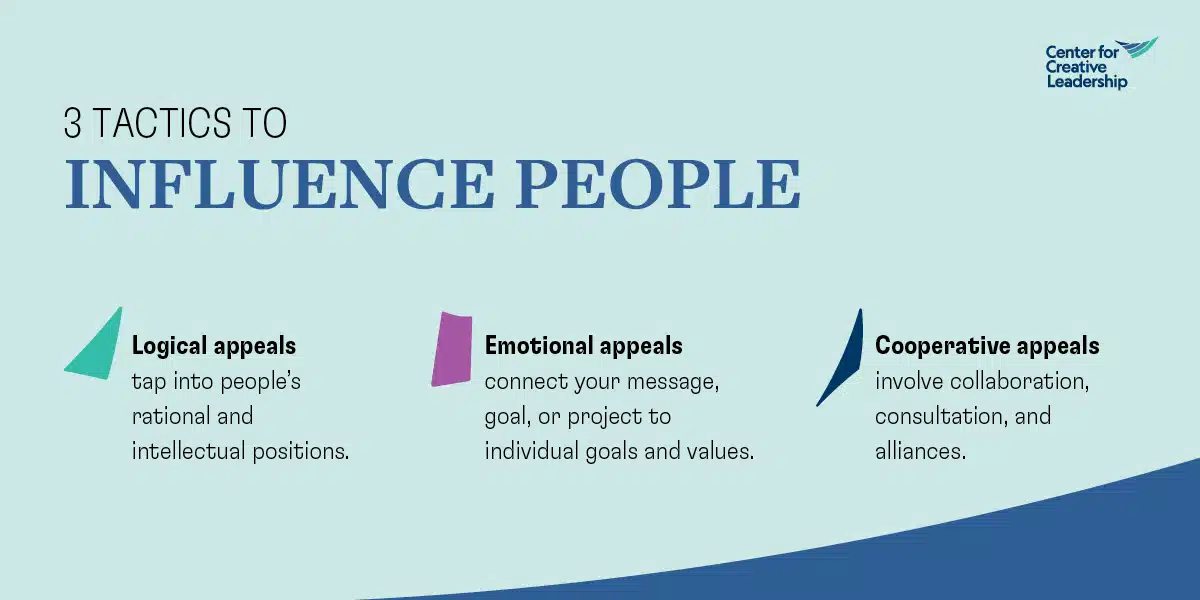Building Commitment and Getting Results
We define leadership as a collective social process leading to direction, alignment, and commitment toward the organization’s goals. In reality, groups or teams consist of individual people with different values, needs, visions, and agendas. As we convince and persuade others around us — bosses, peers, direct reports, superiors, partners, clients, vendors, other divisions — influence is occurring continuously at the workplace. Without persuasion skills, a leader cannot make his or her vision take place.
Influence comes from the Latin influere, meaning to flow into. Influence is the ability of a person or leader to affect, to shape, or to transform the opinions (convincing) and the behaviors or actions (persuading) of other people without necessarily having a formal authority over them. Influencing is soft or personal power, independent of one’s positional power. Persuasion skills allow a leader to get things done and to achieve desired outcomes without coercion.
Influence is something we learn in childhood. It takes place in families, among friends, in communities, at the workplace, and in society more broadly. An average person influences 100 or more people a day. Our research shows that influencing is one of the 4 critical leadership competencies for every leader at every level in the organization.
In this white paper, we help leaders understand the 3 outcomes of influencing, the 3 types of tactics that can be used to influence others, and the 6 essential persuasion skills for effective influencing.
3 Outcomes of Influencing
Influence is an essential part of leadership. The position of a leader in an organization and the power it gives are not enough to motivate or inspire people. A leader promotes or sells their ideas or the ideas of those that they represent. This is particularly important in today’s organizations, which have become less hierarchical and less dependent on individual heroes.
The outcomes of influencing are commitment, compliance, or resistance.
- Commitment: Leaders with developed persuasion skills achieve their goals more effectively. Influencing then results in commitment, which means voluntary support. This goes with a lower need for monitoring, a higher sustained effort over time, a better focus on a shared goal, and improved interpersonal relations.
- Compliance: If a leader’s persuasion skills are less effective, people become compliant. Their attitude and mindset do not change. Consent can lead to higher productivity for well-defined tasks but does not unleash the full potential of engagement and creativity of the talent.
- Resistance: If persuasion skills aren’t effective, the result is resistance either by obstructing or sabotaging, by asking a higher authority to overrule the leader, by attempting to persuade the leader to renounce his or her idea, by looking for excuses, or by pretending to comply (false compliance).
3 Influencing Tactics: The Head, The Heart, The Hands
There are different ways that a leader can influence the behaviors and opinions of others: through facts and logic, through appeals to values and beliefs, or through support of them.
We have found that leaders can influence by applying 3 types of tactics: logical, emotional, and cooperative. These persuasion skills and tactics do not harm relationships when they’re used.
- The Head: Logical influencing tactics address people in a rational or intellectual way. Arguments and information such as facts and figures are brought forward in the best interest of the organization, the team, or the person.
- The Heart: Emotional influencing tactics connect the communication or decision to a person’s feelings of wellbeing or sense of belonging. The leader’s persuasion skills appeal to attitudes, values, a common purpose, ideals, and beliefs through inspiration or enthusiasm.
- The Hands: Cooperative influencing tactics involve seeking advice and offering assistance. The leader reinforces the connection that they have with the others. Collaborating to accomplish a mutually important goal extends a hand to others.
Each person has a preference for how they would like to be influenced. Selecting the best influence tactic is important to achieve the desired outcome with a person or group. Effective leaders understand the way others want to be influenced and apply the right tactics to build alignment and commitment. Leaders who combine the 3 persuasion skills and tactics are likely to be evaluated as better performers.
6 Essential Persuasion Skills
Effectively engaging the Head, the Heart, and the Hands across the many people and situations that a leader encounters requires using a diverse set of persuasion skills. To shape direction, alignment, and commitment through interactions with others, leaders must be skilled in 6 areas:
- Understanding and navigating organizational politics: Organizations have formal and informal structures. Understanding and effectively navigating through complex political situations requires political insight. Leaders adjust to the reality of corporate politics and are sensitive to how the organization functions.
- Creating visibility: To create new opportunities, effective leaders stand out and get noticed by others while staying authentic. They are careful to allow their team members to shine while not over-promoting themselves.
- Building and maintaining personal trustworthiness: Leaders ask others to take risks along with them. Therefore, people must believe in the leader and their leadership. Leaders must show integrity and be widely trusted.
- Leveraging networks: Forming and nurturing a network of relationships is invaluable in today’s interconnected world. Networking allows leaders to generate new experiences, develop persuasion skills, and to tap into the skills and vision of others.
- Clear communication: Writing and speaking clearly and briefly and applying a variety of communication styles helps leaders to get the message across and to ensure the right impact.
- Motivating others: By motivating others, leaders create a climate in which people become engaged and empowered. Leaders understand the needs, styles, and motivators of others. People will like working with and for those leaders and will be more receptive to their influencing.
Download White Paper
Download the full white paper to learn about influencing, manipulation, and power, as well as a more detailed explanation of the components of influence outlined above.










